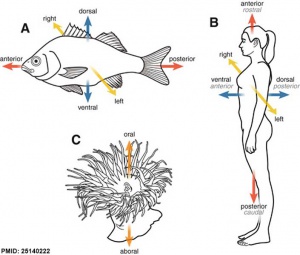K12 Professional Development 2016
Introduction
| All human and animal embryos go through very similar stages of early development. See also Humans and Animal Embryology.
What are the key things in development that we share?
This page introduces a few of the concepts of development shared with all animals.
| Teacher Note
|
 This is currently only a draft designed to help K12 students understand comparative embryology. This is currently only a draft designed to help K12 students understand comparative embryology.
I am currently looking to simplify concepts and include images on this page. I am happy to receive feedback as too what you may like to be included here. I have also begun to add some simple exercises that can be used in class to help understand concepts in embryonic development and comparison. Note some of the links on this page leave the K12 notes section and may be beyond the level of your students, bookmark this page to easily return here. This page can be printed using the lefthand menu "Toolbox" or Printable version.
K12 Professional Development 2016 | K12 Professional Development 2014
|
Meiosis
In the male and female in all animals (and plants) that reproduce sexually to form an embryo, these very first cells form by meiosis.
Meiosis a reductive form of cell division that only occurs in the egg (oocyte) and sperm (spermatozoa) and allows new genetic combinations of offspring to be generated.
Meiosis has 2 key components:
- Genetic reorganisation - the genetic material (chromosomes) that you have from your mother and father are recombined.
- Genetic reductive - the chromosome number is halved and only fertilisation will allow the paired chromosomes that we all contain in all our cells.
Mitosis
| Mitosis is the type of normal cell division that allows growth and development of all animal embryos.
After the first cell has been formed by the egg (oocyte) and sperm (spermatozoa) fusing, every cell division in the embryo forms 2 genetically identical daughter cells.
Mitosis has 2 key components:
- Chromosome duplication - has to occur before cell division can occur.
- Mitosis - a set of 5 standard phases dividing the nucleus (and the chromosomes it contains) before the cytoplasm divides.
|
<html5media height="300" width="300">File:Mitosis 11.mp4</html5media>
|
Patterning
| Development of any animal requires the differentiation of different cell types and tissues from essentially the same initial cells.
The first pattern in all embryos to make the animal's head and body that has a left and right side and a front and back.
The signals used to establish this patterning are shared (similar or the same) between different animals.
|

Animal body patterns
|
Cite this page: Hill, M.A. (2024, April 16) Embryology K12 Comparative Embryology. Retrieved from https://embryology.med.unsw.edu.au/embryology/index.php/K12_Comparative_Embryology
- What Links Here?
- © Dr Mark Hill 2024, UNSW Embryology ISBN: 978 0 7334 2609 4 - UNSW CRICOS Provider Code No. 00098G
|

